700MPa CLASS STEEL BAR HAVING EXCELLENT YIELD RATIO AND UNIFORM ELONGATION PROPERTY, AND METHOD FOR MANUFACTURING THE SAME
LEE; Joonho ; et al.
U.S. patent application number 16/617559 was filed with the patent office on 2020-09-03 for 700mpa class steel bar having excellent yield ratio and uniform elongation property, and method for manufacturing the same. This patent application is currently assigned to KOREA UNIVERSITY RESEARCH AND BUSINESS FOUNDATION. The applicant listed for this patent is FOUNDATION FOR RESEARCH AND BUSINESS, SEOUL NATIONAL UNIVERSITY OF SCIENCE AND TECHNOLOGY, KOREA UNIVERSITY RESEARCH AND BUSINESS FOUNDATION. Invention is credited to Taeun HONG, Byoungchul HWANG, Joonho LEE, Sangin LEE, Sangchul SHIM.
| Application Number | 20200277681 16/617559 |
| Document ID | / |
| Family ID | 1000004854843 |
| Filed Date | 2020-09-03 |
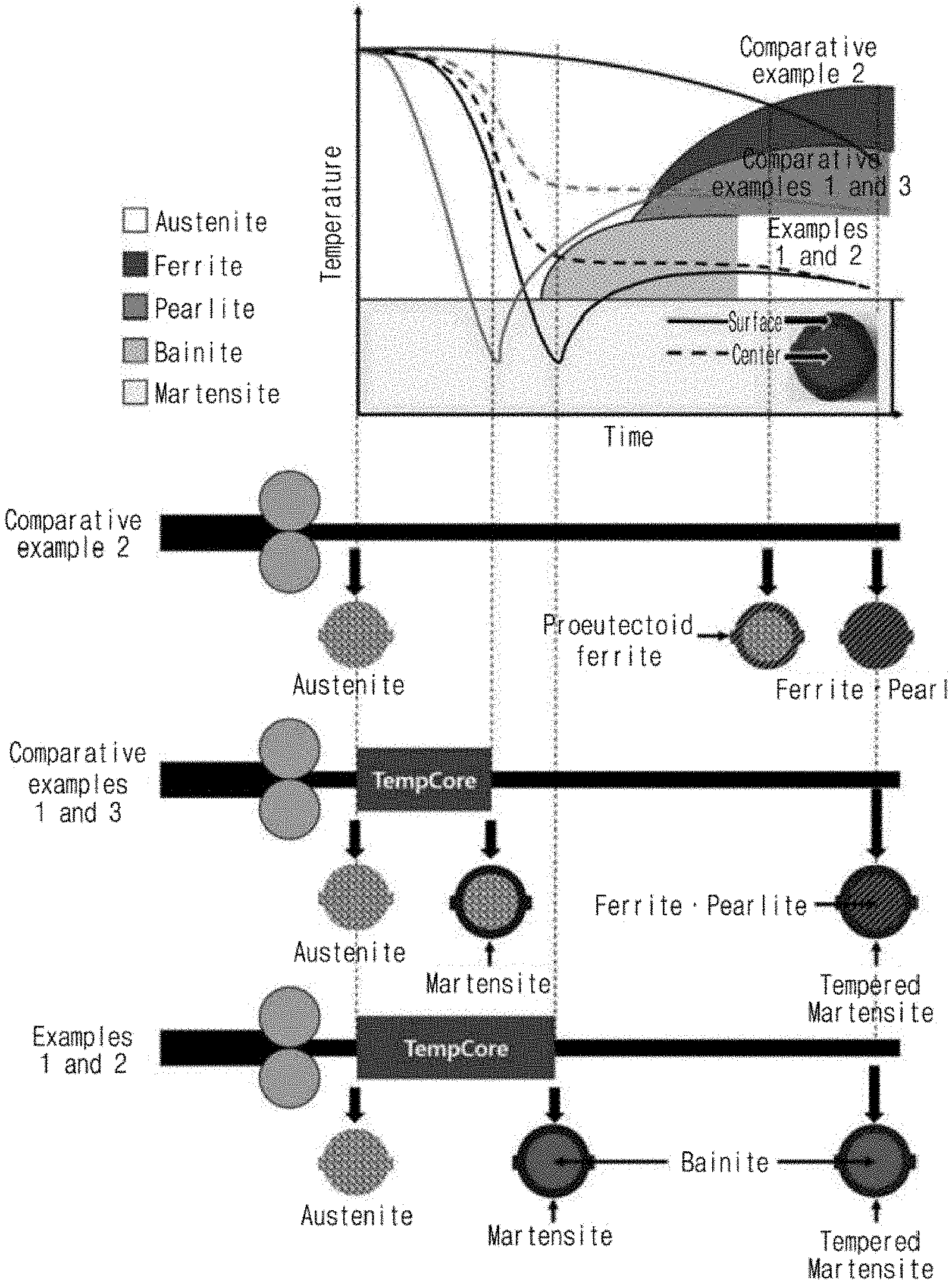
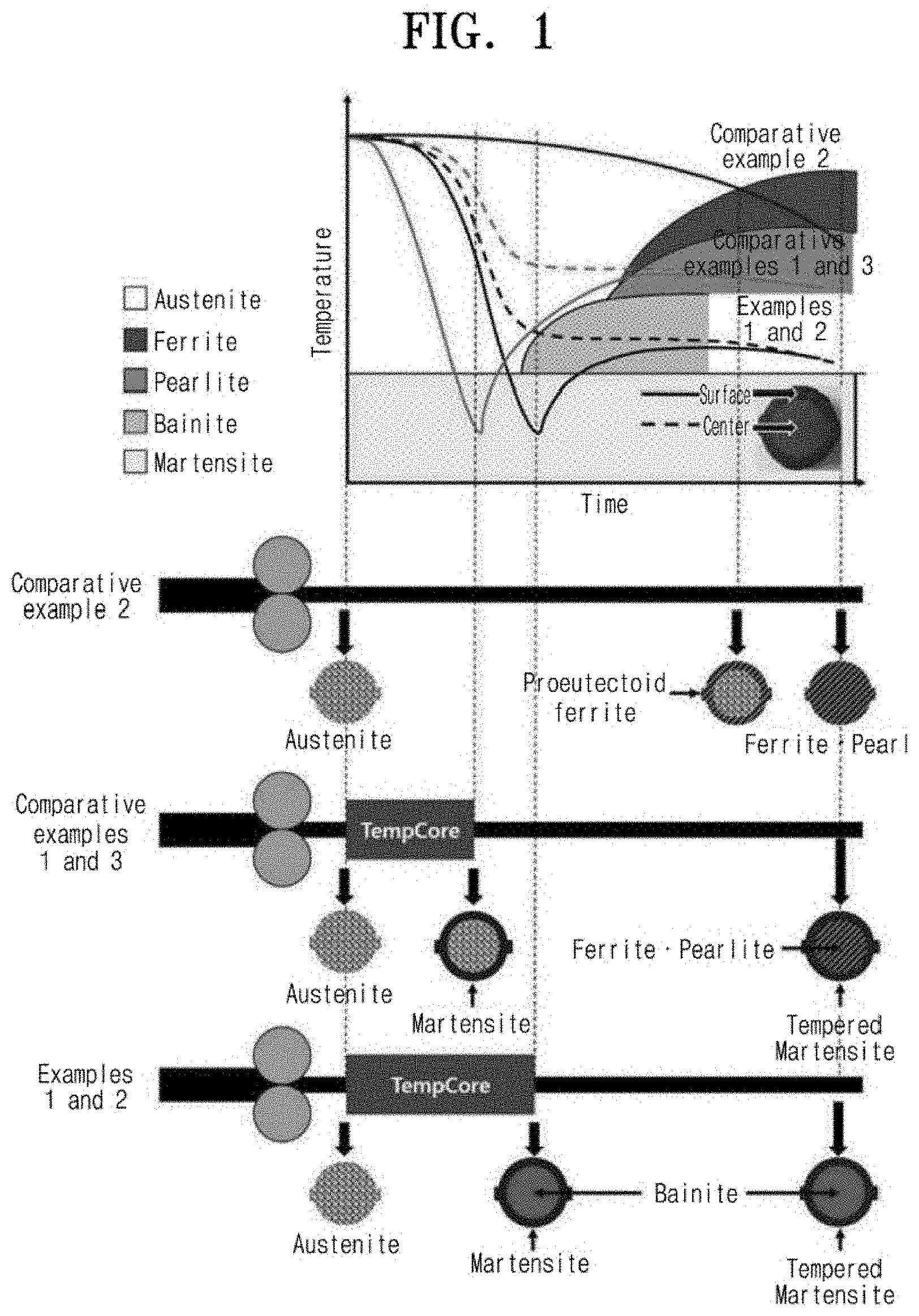
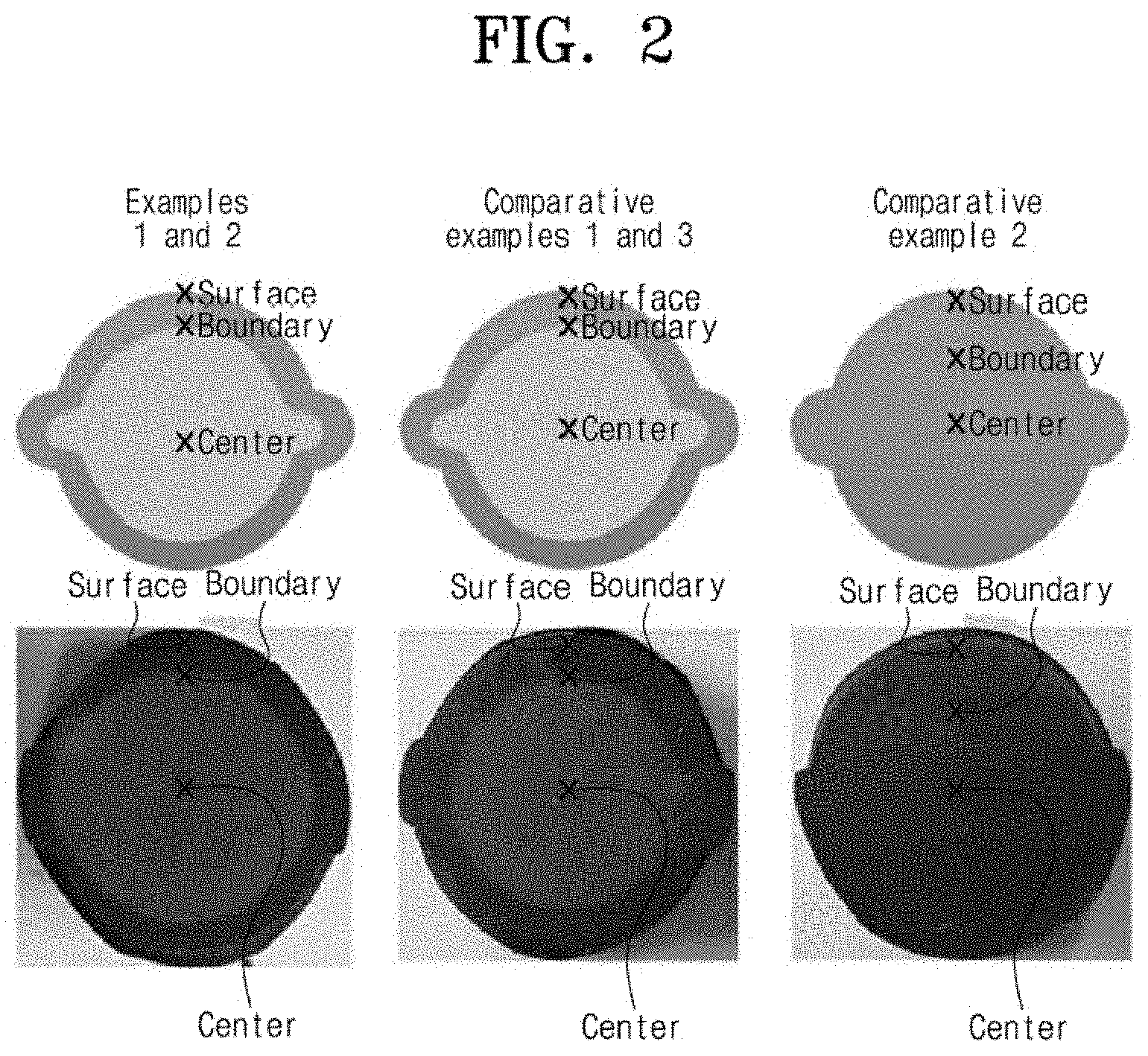
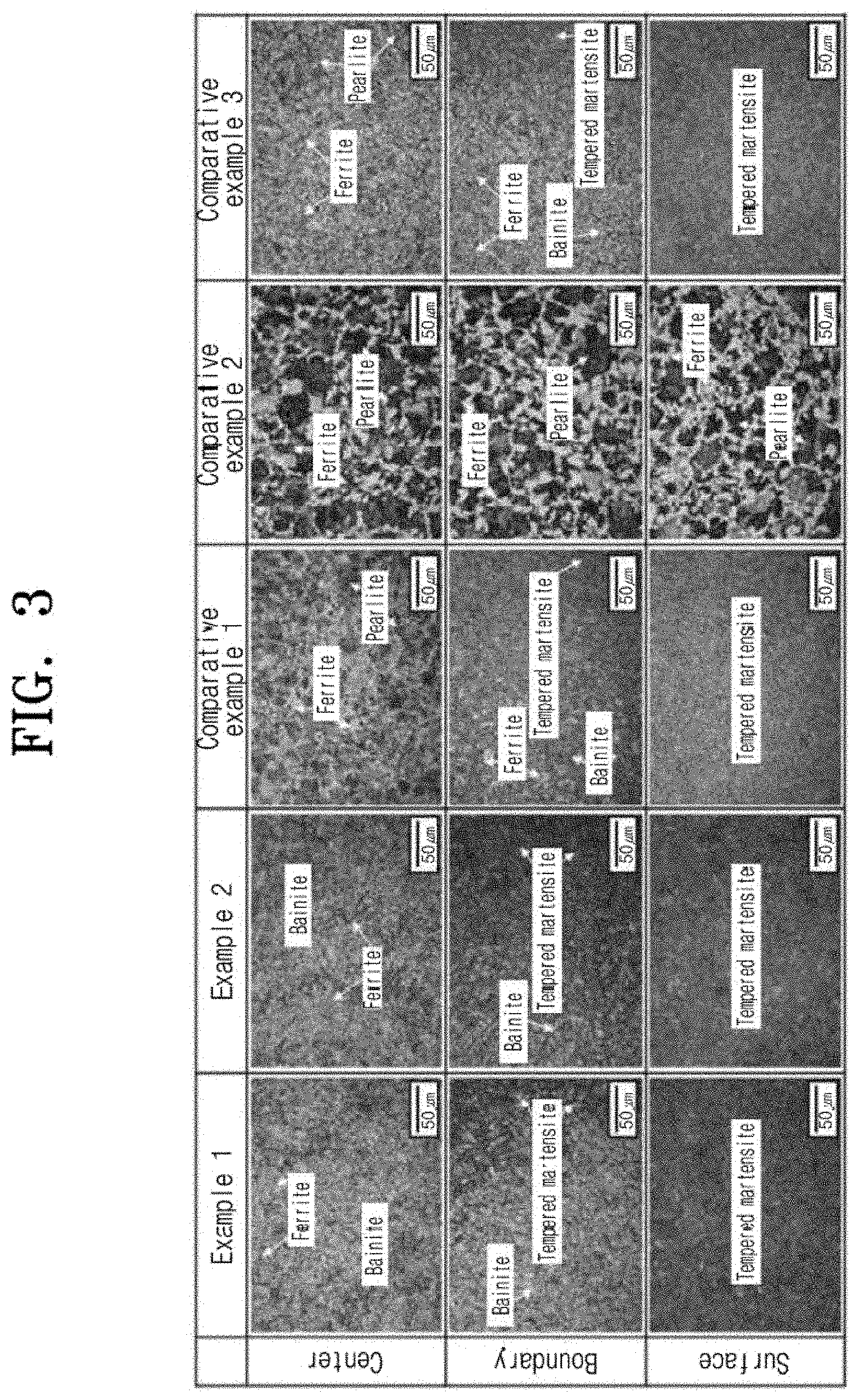
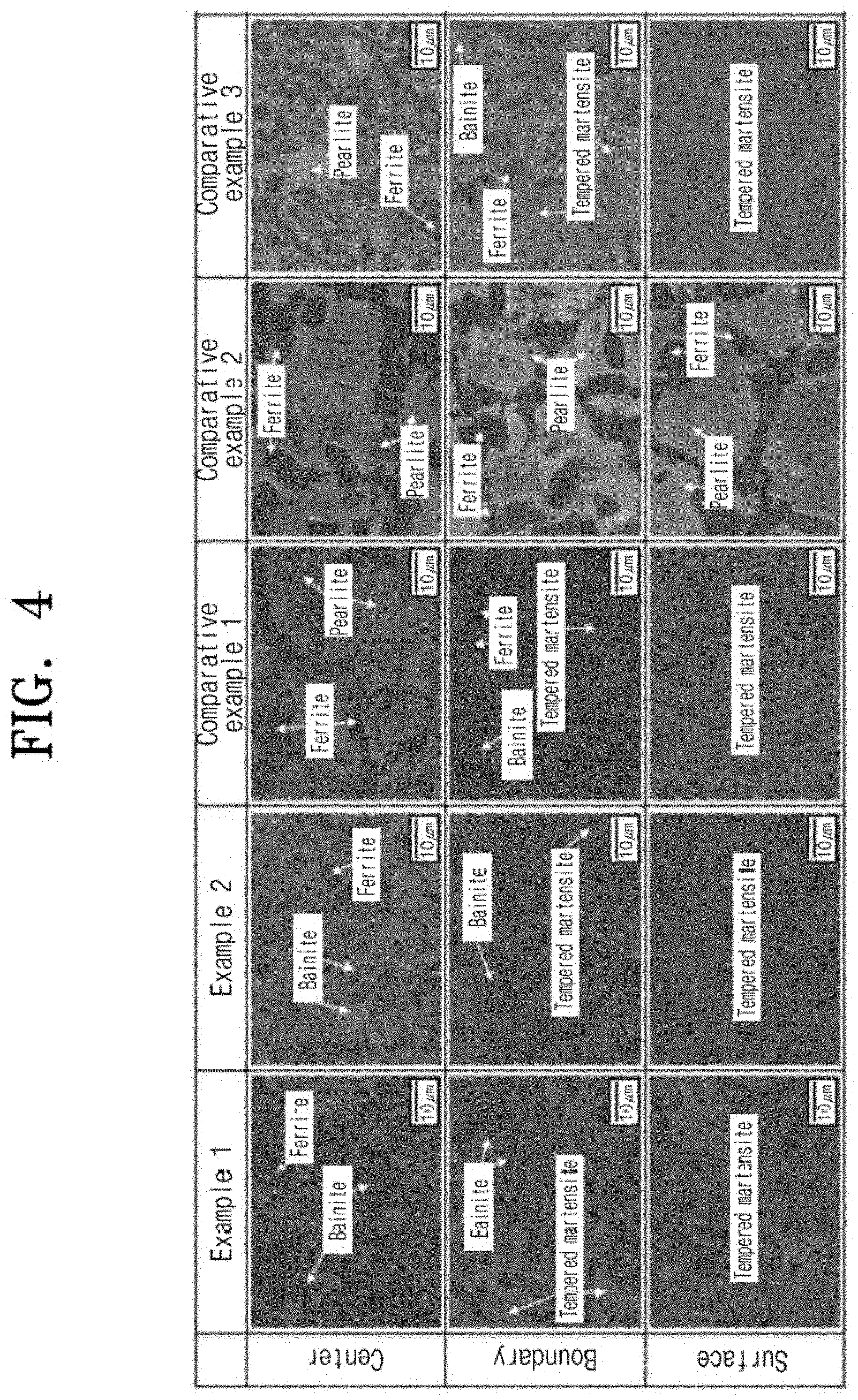
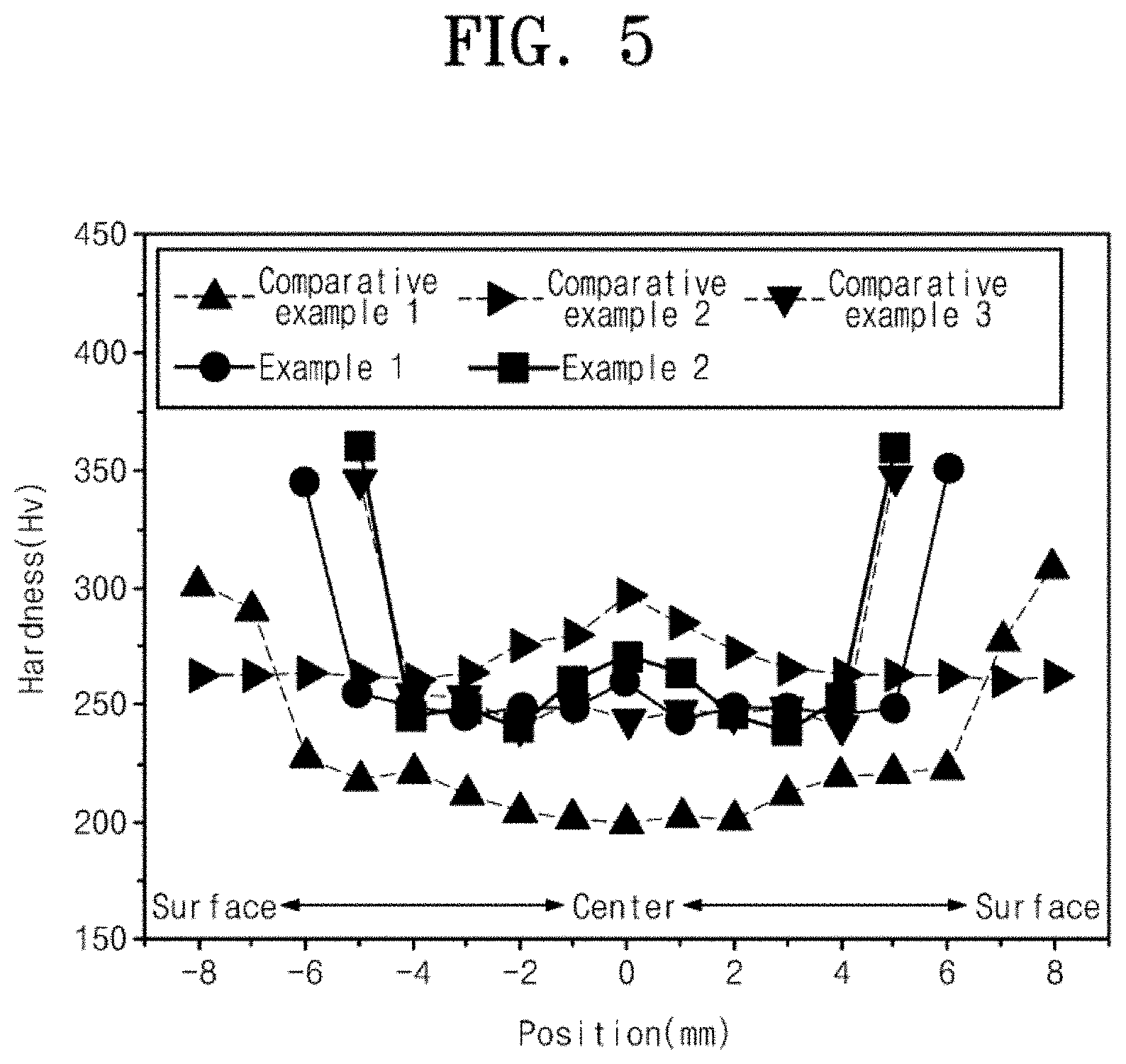
| United States Patent Application | 20200277681 |
| Kind Code | A1 |
| LEE; Joonho ; et al. | September 3, 2020 |
700MPa CLASS STEEL BAR HAVING EXCELLENT YIELD RATIO AND UNIFORM ELONGATION PROPERTY, AND METHOD FOR MANUFACTURING THE SAME
Abstract
A steel bar having yield strength of 700 MPa class, excellent yield ratio, and excellent uniform elongation property is provided. The steel bar includes bainite and ferrite included in a center of the steel bar and bainite accounts for 20 to 80% by volume.
| Inventors: | LEE; Joonho; (Seongnam-si, KR) ; SHIM; Sangchul; (Busan, KR) ; HWANG; Byoungchul; (Seoul, KR) ; HONG; Taeun; (Seoul, KR) ; LEE; Sangin; (Seoul, KR) | ||||||||||
| Applicant: |
|
||||||||||
|---|---|---|---|---|---|---|---|---|---|---|---|
| Assignee: | KOREA UNIVERSITY RESEARCH AND
BUSINESS FOUNDATION Seoul KR FOUNDATION FOR RESEARCH AND BUSINESS, SEOUL NATIONAL UNIVERSITY OF SCIENCE AND TECHNOLOGY Seoul KR |
||||||||||
| Family ID: | 1000004854843 | ||||||||||
| Appl. No.: | 16/617559 | ||||||||||
| Filed: | November 23, 2018 | ||||||||||
| PCT Filed: | November 23, 2018 | ||||||||||
| PCT NO: | PCT/KR2018/014517 | ||||||||||
| 371 Date: | November 27, 2019 |
| Current U.S. Class: | 1/1 |
| Current CPC Class: | C22C 38/02 20130101; C21D 8/065 20130101; C21D 6/005 20130101; C21D 2211/002 20130101; C22C 38/04 20130101; C22C 38/12 20130101; C21D 6/008 20130101; C21D 2211/005 20130101; C21D 9/0075 20130101 |
| International Class: | C21D 9/00 20060101 C21D009/00; C21D 8/06 20060101 C21D008/06; C21D 6/00 20060101 C21D006/00; C22C 38/12 20060101 C22C038/12; C22C 38/04 20060101 C22C038/04; C22C 38/02 20060101 C22C038/02 |
Foreign Application Data
| Date | Code | Application Number |
|---|---|---|
| Nov 16, 2018 | KR | 10-2018-0141344 |
Claims
1. A steel bar having yield strength of 700 MPa class, excellent yield ratio, and excellent uniform elongation property, the steel bar comprising: bainite and ferrite included in a center of the steel bar, wherein the bainite accounts for 20 to 80% by volume.
2. The steel bar of claim 1, wherein the steel bar has the yield strength of 700 to 900 MPa and the yield ratio of 1.25 to 1.50.
3. The steel bar of claim 1, wherein, when manufacturing the steel bar, a bainite structure is formed in the center of the steel bar by a rapid cooling through a Tempcore cooling process.
4. The steel bar of claim 3, wherein the Tempcore cooling process is performed at a speed of the steel bar of 5 to 20 m/sec, a pressure of cool water of 10 to 30 bar, and an amount of water of 100 to 300 m.sup.3/hr.
5. A method of manufacturing a steel bar having yield strength of 700 MPa class, excellent yield ratio, and excellent uniform elongation property, the method comprising: heating a billet for the steel bar; hot-rolling the heated billet to be formed in a steel bar shape; cooling a rolled body having the steel bar shape at a Tempcore; and performing reheating and additional cooling, wherein the cooling at the Tempcore is performed at a speed of the steel bar of 5 to 20 m/sec, a pressure of cool water of 10 to 30 bar, and an amount of water of 100 to 300 m.sup.3/hr.
6. The method of claim 5, wherein, in the heating of the billet for the steel bar, the billet for the steel bar includes carbon (C) of 0.18 to 0.30 wt %, manganese (Mn) of 0.65 to 2.00 wt %, silicon (Si) of 0.13 to 0.40 wt %, vanadium (V) of 0 to 0.10 wt %, the remaining Fe, and other unavoidable impurity components.
7. The method of claim 5, wherein, in the reheating, a temperature of the center of the steel bar is maintained at 500 to 600.degree. C.
8. The method of claim 5, wherein, after the reheating, a structure of the center of the steel bar includes bainite and ferrite.
9. The method of claim 5, wherein, after the reheating and the additional cooling, the steel bar has the yield strength of 700 to 900 MPa and the yield ratio of 1.25 to 1.50.
Description
CROSS-REFERENCE TO RELATED APPLICATIONS
[0001] A claim for priority under 35 U.S.C. .sctn. 119 is made to Korean Patent Application No. 10-2018-0141344 filed on Nov. 16, 2018 and PCT International Application No. PCT/KR2018/014517 filed on Nov. 23, 2018, the entire contents of which are hereby incorporated by reference.
BACKGROUND
[0002] Embodiments of the inventive concept described herein relate to an ultra-high strength steel bar having excellent yield ratio (tensile-to-yield strength, TS/YS) and uniform elongation property and a method of manufacturing the same, more particularly, relate to a steel bar having yield strength of a 700 MPa class having a yield ratio and an excellent uniform elongation property which are suitable for a seismic resistant steel bar, in which a cooling process is improved to increase the yield strength of the steel bar and to increase the yield ratio of the steel bar, and a method of the same.
[0003] In recent years, as a building heightens, a cross-section of a vertical member has increased and a seismic resistant design of the building has attracted attention due to earthquakes occurring around the world. Therefore, importance of development and production technology of a high strength seismic resistant steel bar mainly used as a structural material of the building has increased. The high strength seismic resistant steel bar is designed to have higher yield strength and yield ratio than a general steel bar, thereby withstanding loads in small amounts and improving seismic resistant performance of the building by securing a margin from a start of plastic deformation after elastic deformation to final fracture, and thus damage of human life is minimized.
[0004] In general, the seismic resistant performance of the steel bar is related to a deformation capacity of the material and the deformation capacity is determined by yield ratio or uniform elongation property. Therefore, specification related to the deformation capacity will be important in specification of the ultra-high strength seismic resistant steel bar having the yield strength of 700 MPa class or more. Thus, systematic studies on the high yield strength, the yield ratio, and the uniform elongation property are required to develop the high strength seismic resistant steel bar having the yield strength of 700 MPa class or more.
[0005] In recent, the steel bar is manufactured through various methods and an addition of alloying elements to improve the strength and seismic resistant performance of the steel bar. In particular, a solid solution strengthening and a precipitation strengthening by the addition of the alloying elements have been mainly utilized to secure the strength and seismic resistant performance in a limited manufacturing process. However, excessive addition of alloying elements causes some problems in welding and material cost increase during manufacturing, thereby limiting a carbon equivalent (Ceq) to a specific value or less.
[0006] However, the ultra-high strength seismic resistant steel bar having the yield strength of 700 MPa class or more has not been developed so far.
[0007] Therefore, development of the ultra-high strength seismic resistant steel bar having the yield strength of 700 MPa class or more which is excellent in the yield strength, the yield ratio, and the uniform elongation property has been required.
SUMMARY
[0008] Embodiments of the inventive concept provide an ultra-high strength seismic resistant steel bar having yield strength of 700 MPa class or more.
[0009] Embodiments of the inventive concept provide a seismic resistant steel bar having yield strength of 700 MPa or more, yield ratio of 1.25 or more, and excellent uniform elongation property.
[0010] According to an exemplary embodiment, a steel bar having yield strength of 700 MPa class, excellent yield ratio, and excellent uniform elongation property includes bainite and ferrite included in a center of the steel bar, wherein bainite accounts for 20 or more by volume.
[0011] In addition, according to the inventive concept, the steel bar has the yield strength of 700 to 900 MPa and the yield ratio of 1.25 to 1.50.
[0012] In addition, according to the inventive concept, when manufacturing the steel bar, a bainite structure is formed in the center of the steel bar by a rapid cooling through a Tempcore cooling process.
[0013] In addition, according to the inventive concept, the Tempcore cooling process is performed at a speed of the steel bar of 5 to 20 m/sec, a pressure of cool water of 10 to 30 bar, and an amount of water of 100 to 300 m.sup.3/hr.
[0014] According to an exemplary embodiment, a method of manufacturing a steel bar having yield strength of 700 MPa class, excellent yield ratio, and excellent uniform elongation property includes heating a billet for the steel bar, hot-rolling the heated billet to be formed in a steel bar shape, cooling the rolled body having the steel bar shape at a Tempcore; and performing reheating and additional cooling, wherein the cooling at the Tempcore is performed at a speed of the steel bar of 5 to 20 m/sec, a pressure of cool water of 10 to 30 bar, and an amount of water of 100 to 300 m.sup.3/hr.
[0015] In addition, according to the inventive concept, in the heating of the billet for the steel bar, the billet for the steel bar includes carbon (C) of 0.18 to 0.30 wt %, manganese (Mn) of 0.65 to 2.00 wt %, silicon (Si) of 0.13 to 0.40 wt %, vanadium (V) of 0 to 0.10 wt %, the remaining Fe, and other unavoidable impurity components.
[0016] In addition, according to the inventive concept, in the reheating, a temperature of the center of the steel bar is maintained at 500 to 600.degree. C.
[0017] In addition, according to the inventive concept, after the reheating, a structure of the center of the steel bar includes bainite and ferrite.
[0018] In addition, according to the inventive concept, after the reheating and the additional cooling, the steel bar has the yield strength of 700 to 900 MPa and the yield ratio of 1.25 to 1.50.
BRIEF DESCRIPTION OF THE FIGURES
[0019] The above and other objects and features will become apparent from the following description with reference to the following figures, wherein like reference numerals refer to like parts throughout the various figures unless otherwise specified, and wherein:
[0020] FIG. 1 shows temperature change of steel bars and structure change by location depending on processes of Examples and Comparative Examples;
[0021] FIG. 2 shows cross-sectional views of steel bars of Examples according to the inventive concept and Comparative Examples;
[0022] FIG. 3 shows optical micrographs of Examples according to the inventive concept and Comparative Examples;
[0023] FIG. 4 shows scanning electron micrographs of Examples according to the inventive concept and Comparative Examples; and
[0024] FIG. 5 shows a graph showing positional hardness of Examples according to the inventive concept and Comparative Examples.
DETAILED DESCRIPTION
[0025] Hereinafter, embodiments of the inventive concept will be described in detail with reference to the accompanying drawings. The embodiment of the inventive concept may be modified in various forms, and the scope of the inventive concept should not be construed as being limited to the following embodiments. These embodiments are provided to more fully describe the inventive concept to those skilled in the art. Thus, shapes of elements of the drawings have been exaggerated to emphasize a clearer description.
[0026] The inventive concept provides a method of a steel bar having yield strength of 700 MPa class, which is excellent in yield ratio and uniform elongation property, including heating a billet for a steel bar; hot-rolling the heated billet to be formed in a steel bar shape; cooling the rolled billet having the steel bar shape at a Tempcore; and performing reheating and additional cooling.
[0027] According to the inventive concept, the billet for the steel bar may include carbon (C) of 0.18 to 0.30 wt %, manganese (Mn) of 0.65 to 2.00 wt %, silicon (Si) of 0.13 to 0.40 wt %, vanadium (V) of 0 to 0.10 wt %, the remaining Fe, and other unavoidable impurity components.
[0028] Carbon (C) is an effective element for increasing strength. When an amount of carbon (C) is low, desired high strength is not obtained and when the amount of carbon (C) is high, the strength is increased but deterioration of toughness and ductility shows a remarkable increase. Therefore, carbon (C) is preferably 0.18 to 0.30 wt % to obtain the high strength.
[0029] Manganese (Mn) has an effect of increasing the strength during a heat treatment. Manganese (Mn) is an essential element for strength compensation because the amount of C added is limited. When the amount of manganese (Mn) is low, the effect of improving hardenability is almost absent. When manganese (Mn) exceeds a specific range, weldability is lowered and risk of cracking is increased. Therefore, the amount of manganese (Mn) is preferably 0.65 to 2.00 wt %.
[0030] Silicon (Si) is an element essential for deoxidation of a steel and for improving the strength. When an amount of silicon (Si) is 0.10 wt % or less, the desired high strength is hardly obtained. When the amount of silicon (Si) exceeds a specific range, the toughness and the ductility decrease. Accordingly, the amount of silicon (Si) is preferably 0.13 to 0.40 wt %.
[0031] Vanadium (V) is added to ensure the strength by solid solution strengthening and precipitation strengthening. Vanadium plays roles of preventing movement at an austenite grain boundary during the heating and the hot-rolling to make austenite grains fine, of suppressing nucleation at the austenite grain boundary to increases the hardenability of the steel bar, and of being combined with carbon or nitrogen and forming a precipitate to improve the strength of the steel bar. However, when vanadium (V) is excessively added, cracking may occur during the rolling. Therefore, vanadium (V) is preferably more than 0 and 0.01 wt % or less.
[0032] In the heating of the billet for the steel bar, all carbides and carbonitrides, which are added substances, are completely dissolved, and a heating temperature is 900 to 1100.degree. C.
[0033] After the heating of the billet for the steel bar, the heated billet is subjected to the hot-rolling.
[0034] In the hot-rolling after the heating of the billet for the steel bar, the heated billet may be formed in the steel bar shape through a roughing mill, an intermediate mill, and a finishing mill. The hot-rolling process is a method of manufacturing a general steel bar, and a hot-rolling technology is not particularly limited.
[0035] The cooling at the Tempcore is performed after the hot-rolling.
[0036] In the inventive concept, a cooling condition is important in the cooling at the Tempcore. In a case of a rapid cooling, a condition where bainite is sufficiently formed in the center may be satisfied, and thus a bainite structure may be formed.
[0037] That is, in the reheating after the rapid cooling, a section in which bainite is formed in the center is maintained for a long time to form the bainite structure of 20% by volume or more
[0038] Preferably, the bainite structure may be formed 20 to 80% by volume.
[0039] The cooling at the Tempcore may be performed by water cooling. In a cooling line of the Tempcore, a rolled body of the steel bar, a position of a cooling equipment, and an amount of cooling water are determined. To this end, the amount of cooling water and the speed are adjusted to convert austenite to martensite at a surface of the steel bar, and thus a cooling rate may be determined after the rolled body of the steel bar is reheated above a start temperature of bainite formation at the center upon a final reheating.
[0040] The bainite formation temperature may be 500 to 600.degree. C. At an end of the cooling process at the Tempcore, the center maintains the temperature of 500 to 600.degree. C. In the reheating, the center maintains the temperature of 500 to 600.degree. C.
[0041] To this end, the speed of the steel bar, pressure of water, and the amount of water may be adjusted in the cooling at the Tempcore. The speed of the steel bar may be 5 to 20 m/sec, the pressure of water may be 10 bar or more, preferably 10 to 20 bar, and the amount of water may be 100 m.sup.3/hr or more, preferably 100 to 300 m.sup.3/hr.
[0042] The speed of the steel bar, the pressure of water, and the amount of water may be adjusted in the cooling at the Tempcore to form a tempered martensite structure in the surface and a low-temperature metamorphic structure such as tempered martensite and bainite in a boundary, from the first austenite through the cooling process. In addition, bainite is mainly formed in the center and ferrite is formed in the rest
[0043] In the center, bainite accounts for 20% by volume or more, and the rest is occupied by ferrite. Preferably bainite may account for 20% to 80% by volume. This is possible because the cooling at the Tempcore rapidly lowers to a temperature at which bainite is formed and then the bainite formation temperature is maintained in the reheating.
[0044] The inventive concept is characterized by maintaining the section, in which bainite is formed in the center of the steel bar, for a long time through the reheating process after the cooling. Therefore, a specific amount or more of bainite is formed and thus the yield strength is improved.
[0045] The reheating is performed after the cooling at the Tempcore. The reheating may be performed through self-tempering.
[0046] In the reheating, it may be important to change the temperature of the center of the steel bar at a constant temperature and the bainite structure may be formed in the center. To this end, in the inventive concept, in the reheating, the temperature of the center may be maintained to be 500 to 600.degree. C., which is a section in which bainite may be formed.
[0047] That is, it is important to create a condition in which bainite is formed in the center of the steel bar by slow moving speed and the rapid cooling through high water pressure in the Tempcore process and to maintain the condition a long time in the reheating.
[0048] The reheating process takes about 0.3 to 1 second after the cooling at the Tempcore.
[0049] After the reheating, the additional cooling through air cooling is provided. The additional cooling is performed at a cooling rate of 10.about.20.degree. C./sec to be cooled to 200.degree. C. or less. In the air cooling, a flow in the air occurs for quick cooling to be cooled.
[0050] Hereinafter, Examples of the inventive concept will be described in detail.
Example 1
[0051] Example 1 included carbon (C) of 0.34 wt %, manganese (Mn) of 1.07 wt %, silicon (Si) of 0.15 wt %, vanadium (V) of 0.04 wt %, the remaining Fe, and other unavoidable impurity components, which were heated at about 1000.degree. C. (heating a billet for a steel bar)
[0052] After the heating the billet for the steel bar, hot-rolling was performed to be formed in a steel bar shape through a roughing mill, an intermediate mill, and a finishing mill.
[0053] After the hot-rolling, cooling at a Tempcore was performed at a speed of the steel bar of 10 m/sec, a pressure of cool water of 10 bar, and an amount of water of 150 m.sup.3/hr.
[0054] After the cooling at the Tempcore, reheating and additional cooling were performed. The additional cooling was carried out by an air cooling manner to complete the steel bar.
Example 2
[0055] The same as Example 1, but
[0056] Example 2 included carbon (C) of 0.33 wt %, manganese (Mn) of 1.12 wt %, silicon (Si) of 0.15 wt %, vanadium (V) of 0.04 wt %, the remaining Fe, and other unavoidable impurity components.
[0057] In addition, after the heating, the cooling at the Tempcore was carried out at the speed of the steel bar of 5 m/sec, the pressure of cool water of 15 bar, and the amount of water of 150 m.sup.3/hr.
Comparative Example 1
[0058] The same process as in Example 1, but
[0059] Comparative Example 1 included carbon (C) of 0.29 wt %, manganese (Mn) of 0.52 wt %, silicon (Si) of 0.14 wt %, the remaining Fe, and other unavoidable impurity components.
[0060] The cooling at the Tempcore was carried out at the speed of the steel bar of 30 m/sec through the air cooling.
Comparative Example 2
[0061] The same process as Example 1, but
[0062] Comparative Example 2 included carbon (C) of 0.30 wt %, manganese (Mn) of 1.15 wt %, silicon (Si) of 0.16 wt %, vanadium (V) of 0.11 wt %, the remaining Fe, and other unavoidable impurity components.
[0063] In addition, only cooling by air cooling was performed, not cooling at the Tempcore.
Comparative Example 3
[0064] The same process as Example 2, but
[0065] Comparative Example 3 included carbon (C) of 0.32 wt %, manganese (Mn) of 1.08 wt %, silicon (Si) of 0.15 wt %, vanadium (V) of 0.04 wt %, the remaining Fe, and other unavoidable impurity components.
[0066] The cooling at the Tempcore was carried out at the speed of the steel bar of 30 m/sec through the air cooling.
[0067] The properties of the steel bars prepared by Examples 1, 2 and Comparative Examples 1 to 3 summarized in Table 1 below.
TABLE-US-00001 TABLE 1 Yield Ratio (Tensile Yield Tensile Strength/ Uniform Total Strength Strength Yield Elongation Elongation (Mpa) (Mpa) Strength) property (%) property (%) Example 1 705 886 1.26 7.4 11.1 Example 2 711 908 1.28 6.7 8.8 Comparative 667 777 1.16 11.2 16.8 Example 1 Comparative 643 883 1.37 10.1 13.6 Example 2 Comparative 611 816 1.34 8.3 11.0 Example 3
[0068] The steel bars of Comparative Examples have a conventional steel bar performance having yield strength of 600 MPa class. The steel bars of Examples 1 and 2 of the inventive concept show yield ratio property of 1.25 or more and high uniform elongation property of 5.0% or more, although having a very high strength of 700 MPa or more.
[0069] That is, the steel bar according to the inventive concept having the yield strength of 700 MPa or more, which is excellent in the yield ratio and uniform elongation property, may be confirmed that the yield and tensile strength is increased in comparison with the conventional steel bar. This is believed that the center is formed of the bainite structure of 20% or more and the surface is formed of tempered martensite. Details of an internal structure and hardness characteristics of the steel bars will be described with reference to the drawings.
[0070] FIG. 1 shows temperature change of steel bars and structure change by location depending on processes of Examples and Comparative Examples.
[0071] Referring to FIG. 1, in the case of Example 1 and Example 2, after the hot-rolling, in the cooling at the Tempcore, the slow moving speed, rapid quenching degree `H` due to high water pressure, and the reheating cause bainite of 20% by volume or more to be formed in the center and tempered martensite to be formed in the surface
[0072] The Tempcore process (the rapid cooling through the slow moving speed and the high pressure of water) creates the condition for bainite to be formed in the center of the steel bar and then the condition is maintained for a long time during the reheating, and thus lots of bainite structures are formed in the center.
[0073] As shown in FIG. 1, the centers of Examples 1 and 2 are adjusted by the section where bainite is formed due to the rapid cooling. The section is maintained to form lots of bainite structures.
[0074] On the contrary, in the case of Comparative Example 1 and Comparative Example 3, after the cooling at the Tempcore, the air cooling is carried out through the reheating process. In the case of the steel bar performing the cooling at the Tempcore, martensite is formed in the surface of the steel bar by the Tempcore. Then in the air cooling, martensite is self-tempered by reheating to form tempered martensite, and ferrite and pearlite are formed from retained austenite. Eventually, tempered martensite is shown in the surface and microstructure property of ferrite-pearlite is shown in the center.
[0075] In the case of Comparative Example 2, the microstructure property of ferrite-pearlite is shown in both the surface and the center due to the air cooling process.
[0076] In the case of Comparative Examples 1 to 3, since the cooling is not performed until bainite is formed in the center, the bainite is hardly formed.
[0077] FIG. 2 shows cross-sectional views of steel bars of Examples according to the inventive concept and Comparative Examples.
[0078] Referring to FIG. 2, the steel bars of Example 1 and Example 2 may be confirmed that the boundary is formed between the surface and the center and is defined by a different structure from tempered martensite formed in the surface and bainite and ferrite formed in the center.
[0079] In Comparative Examples 1 and 3, it may be confirmed that the boundary is formed between the surface and the center and is defined between tempered martensite, and ferrite and pearlite of the center.
[0080] In the case of Comparative Example 2, the boundary is not distinguished because both the surface and the center have a structure of ferrite and pearlite.
[0081] FIGS. 3 and 4 show optical micrographs and scanning electron micrographs of Examples according to the inventive concept and Comparative Examples.
[0082] Referring to FIGS. 3 and 4, in the case of Examples 1 and 2, not only tempered martensite is formed in the surface but also bainite having a large ratio is formed in the center due to the slow speed and the high water pressure during the cooling at the Tempcore, and thus the yield strength may be 700 MPa or more and the yield ratio may be 1.25.
[0083] On the contrary, in Comparative Examples 1 and 3, bainite and tempered martensite are partially formed at the boundary due to the cooling at the Tempcore, and tempered martensite is formed in the surface, but soft ferrite and pearlite structure is formed in the center, and thus the yield strength is less than 700 MPa.
[0084] In the case of Comparative Example 2, the surface, the boundary, and the center are formed the soft ferrite, pearlite structure, and thus the yield strength is less than 700 MPa.
[0085] FIG. 5 shows a graph showing positional hardness of Examples according to the inventive concept and Comparative Examples.
[0086] Referring to FIG. 5, it may be seen that the steel bars of Example 1 and Example 2 have similar or higher hardness in all positions in comparison with the steel bars of Comparative Example 1 and Comparative Example 3 manufactured through the Tempcore.
[0087] Particularly, in the case of the hardness of the center, it may be seen that the hardness characteristics of steels bars of Examples 1 and 2 were superior to those of the steel bars of Comparative Examples 1 and 3 because the bainite structure of 20% by volume or more is formed in the steel bars of Examples 1 and 2.
[0088] However, in the case of Comparative Example 2 subjected to the air cooling after hot-rolling, the highest hardness at the center is showed. In the case of Comparative Example 2, a large amount of vanadium (V) is added to compensate for the low strength of the ferrite-pearlite structure, thereby performing precipitation strengthening. Therefore, in the case of Comparative Example 2, it may be seen that the hardness of the center is the largest by a large amount of vanadium carbide.
[0089] In conclusion, it may be confirmed that the steel bar according to the inventive concept is the steel bar having the yield strength of 700 MPa or more, the yield strength of 1.25 or more, and the excellent uniform elongation property because the bainite structure of 20% by volume or more is formed in the center and the tempered martensite is formed in the surface.
[0090] According to one embodiment of the inventive concept, bainite accounts for 20% by volume or more in the center of the steel bar and thus the steel bar has the yield strength of 700 MPa or more and the yield ratio of 1.25 or more, which is suitable for the seismic resistant steel bar.
[0091] The steel bar having the yield strength of 700 MPa class, which is excellent in the yield ratio and the uniform elongation property, according to the inventive concept is provided as the seismic resistant steel bar having the yield strength of 700 MPa or more, the high yield ratio, and the high uniform elongation property of 5% or more.
[0092] In the inventive concept, after the rolling process, the condition of the cooling of the steel bar is changed to form the bainite structure in the center of the steel bar at the specific ratio or more, to increase the uniform elongation property of the steel bar, and to increase the yield ratio of 1.25 or more, thereby greatly improving the quality of the seismic resistant steel bar.
[0093] While the inventive concept has been described with reference to exemplary embodiments, it will be apparent to those skilled in the art that various changes and modifications may be made without departing from the spirit and scope of the inventive concept. Therefore, it should be understood that the above embodiments are not limiting, but illustrative.
* * * * *
D00000

D00001

D00002

D00003

D00004

D00005

XML
uspto.report is an independent third-party trademark research tool that is not affiliated, endorsed, or sponsored by the United States Patent and Trademark Office (USPTO) or any other governmental organization. The information provided by uspto.report is based on publicly available data at the time of writing and is intended for informational purposes only.
While we strive to provide accurate and up-to-date information, we do not guarantee the accuracy, completeness, reliability, or suitability of the information displayed on this site. The use of this site is at your own risk. Any reliance you place on such information is therefore strictly at your own risk.
All official trademark data, including owner information, should be verified by visiting the official USPTO website at www.uspto.gov. This site is not intended to replace professional legal advice and should not be used as a substitute for consulting with a legal professional who is knowledgeable about trademark law.